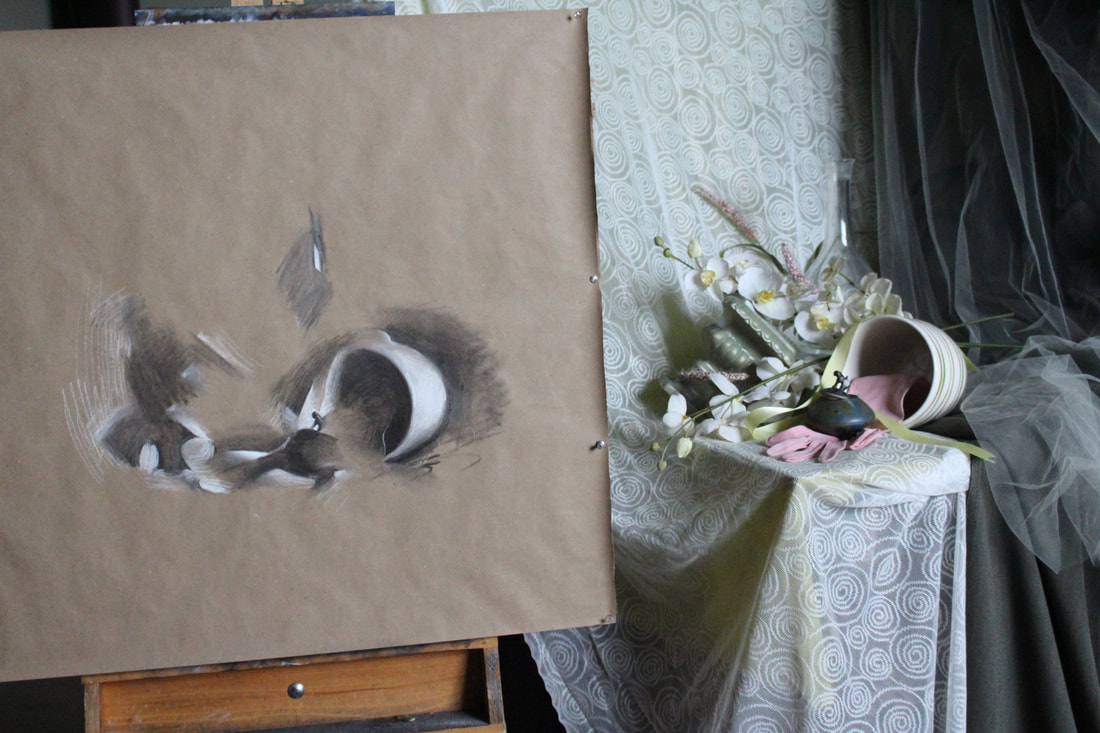|
In a previous post, I said that still life offers all of the best that the art of painting has to offer - not only the object painted, but what it does, visually. Falling in love with the visual. The next step (and a harder step) in understanding painting is to understand what objects are doing together. This is something that has dawned upon me gradually (and I am sure that my understanding is still incomplete). One particular way that I have come to know the harmony of different objects working together is the concept of a color scheme. So what is a color scheme? In college I learned one step more than I leaned in 3rd grade. In grade school I heard about complimentary colors: red and green, blue and orange, purple and yellow... these colors are "complementary colors." Later on in college someone presented the idea that pictures should have "complementary color schemes." What this boiled down to was: pick a "red" and a "green" and build up a picture using them; this will give your picture a unity and good contrasts and will make it look more like it has a "color scheme." For me this presentation of the idea was anything but compelling. I believe in large part it was so because the ideas were poorly communicated -- but I also suspect that those teaching me had, in fact, a very shallow understanding of them as well. I suspect some of the teachers didn't really "believe in" or rather understand that color has certain rules and laws to be discovered. Even among many trained painters it is common to say things like "color is entirely relative" or "color is just such a personal thing." In my years of study with Paul I discovered that this simply is not the case. A large part of discovering the truth about color is jettisoning a lot of partial, formulaic knowledge about "color scheme" and what it means to be a "complementary color." I had just to observe what two colors do together. This exercise can be a very hard and trying thing. Looking for something, trying to observe something about the relationship between two colors that, initially, you can barely imagine. Paul encouraged me to find two colors that "looked magical" together. What did that even mean? They had to look better together than when they were apart. If a certain red looked good with a certain blue Paul would ask "did you try EVERY red with that blue?" This was very challenging: had I really seen every red with this blue? Was there a better one? And often the answer was "yes, there was a better one." Over time, my judgment and perceptions became sharper and sharper and before long, by trial and error of learning to see color relationships, I got to the point where I knew when colors were magical together. This is one aspect of the harmony that drives mature artists to make still life. There are many others that exist: shape harmony, value rhythms, lost and found, the play of main lines, gesture and movement, transitions, and many more. These larger unities comprise the "game" of visual harmony and are what bring artists back to picture making again and again. Watching for them and understanding them will make you a more discerning art appreciator and will open up a world in which you can delight in still life.
4 Comments
6/21/2018 08:43:45 pm
Thank you John for sharing an informative ideas regarding art. I do admit that even if I love making art, I still do not know the meaning of some. One thing is for sure is that, I really appreciate color rendering into the arts. Color is one of the important roles in doing arts due to it gives the life of art, it says the emotion of it and expresses the feeling of it. It makes the art, lively and hook others for them to appreciate it.
Reply
7/12/2018 06:36:39 pm
Tough question I say. Aren't we all a huge fan of photographs for one? So why paint something we can already just capture and resize to customize our preferences? Who says we are going to paint something we can capture? That's the huge difference. Yes, I like still life, but I also like to see things I don't see everyday or even impossible for me to see. I want to recreate floating roses. I want flying seashells. I want my favorite faces to wear wings.
Reply
John Folley
7/27/2018 05:51:41 am
Thank you very much for your comment. I find it very interesting and I think it brings up some very good questions. Let's separate it into two parts.
John Folley
7/27/2018 05:54:23 am
I certainly agree that color can certainly be the life in a piece! Aristotle describes painting as "the art of color" after all! It is very interesting to compare and contrast photographic capturing of reality with painted capturing reality for this reason as well. One will notice striking differences, and often in my experience, the camera is less real in its capturing of life.
Reply
Leave a Reply. |
AuthorHello there, I'm John H. Folley, an oil painter in the Boston School tradition. Thanks for visiting the Beauty Advocacy Blog, where it's my job to help you become a more discerning art appreciator. Connect with John:
Categories
All
Archives
February 2024
|

